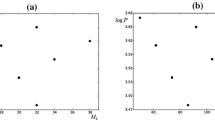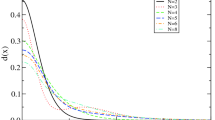Abstract
The direction of valence is defined as the direction from the atomic nucleus to the center of gravity of the hybrid density. Complex mixing coefficients of the orbitals of pure angular momentum are introduced in the hybrid. This allows a considerable extension of the hybridization concept with regard to valence angles and equivalence restrictions. General expressions for the direction consines of valence and for bond angles are given, and applications are made to several molecules with bond angles of 90 degrees or less.
Zusammenfassung
Die Valenzrichtung eines Hybrids wird als die Richtung vom Atomkern zum Schwerpunkt der Elektronendichte difiniert. Dabei werden auch komplexe Koeffizienten für die atomaren Zustandsfunktionen zugelassen, wodurch eine erhebliche Erweiterung des Hybridisierungs-konzeptes im Hinblick auf Valenzwinkel und Nebenbedingungen infolge von Äquivalenz möglich ist. Allgemeine Ausdrücke für die Richtungskosinus und Bindungswinkel werden angegeben, ebenso einige Beispiele für Moleküle mit Winkeln unter 90‡.
Résumé
La direction de valence est définie comme la direction joignant le noyau atomique au centre de gravité de la densité de l'hybride. Des coefficients de mélange complexes sont introduits dans l'hybride pour les orbitales de moment angulaire pur. Ceci permet une extension considérable du concept d'hybridation en ce qui concerne les angles de valence et les restrictions d'équivalence. Des expressions générales pour les cosinus directeurs des directions de valence et pour les angles de liaison sont obtenues et appliquées á plusieurs molécules dont les angles de liaison sont au plus de 90‡.
Similar content being viewed by others
References
Pauling, L.: Proc. Nat. Acad. Sci. US 14, 359 (1928).
—: J. Am. Chem. Soc. 53, 1367 (1931).
—: Nature of the chemical bond, ed. 3, p. 108 ff. Ithaca, N. Y.: Cornell Univ. Press 1961.
Slater, J. C.: Physic. Rev. 37, 481 (1931).
Coulson, C. A.: Proc. Roy. Soc. (Edinburgh) 61, 115 (1941).
Coulson, C. A.: Valence, p. 104 ff. Oxford: University Press 1952.
Löwdin, P. O.: J. chem. Physics 21, 496 (1953).
Del Re, G., U. Esposito und M. Carpentieri: Theoret. chim. Acta 6, 36 (1966).
Veillard, u. G. Del Re: Theoret. chim. Acta 2, 55 (1964).
Flygare, W. H.: Science 140, 1179 (1963).
Löwdin, P. O.: Correspondence between concepts in chemistry and quantum chemistry, (unpublished). Proceedings of a panel meeting held at Vålådalen, Sweden, August 26–30, 1958; mimeographed note from the Quantum Chemistry Group, p. 17. Uppsala
Author information
Authors and Affiliations
Rights and permissions
About this article
Cite this article
Mårtensson, O., öhrn, Y. On the complex hybridization of orbitals of s and p type. Theoret. Chim. Acta 9, 133–139 (1967). https://doi.org/10.1007/BF00529947
Received:
Issue Date:
DOI: https://doi.org/10.1007/BF00529947




